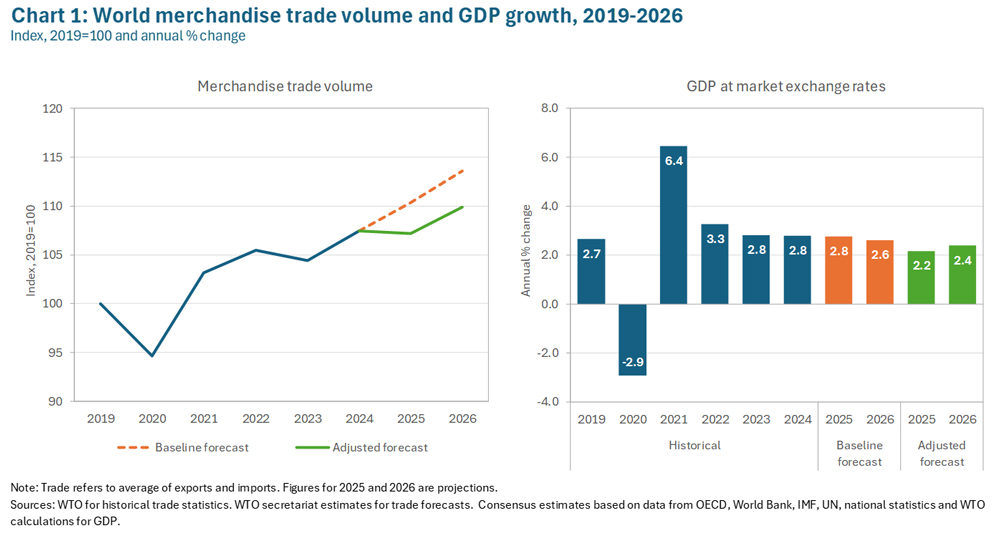The World Trade Organization (WTO) has significantly downgraded its forecast for global merchandise trade in 2025, now anticipating a 0.2% contraction under current conditions. This stark revision, detailed in the WTO Secretariat’s latest Global Trade Outlook and Statistics report released on April 16th, stands nearly three percentage points below the projected growth under a “low tariff” baseline scenario. The current forecast is based on the tariff landscape as of April 14th.
Alarmingly, the WTO cautions that trade could shrink even further, potentially plummeting to -1.5% in 2025, should trade tensions escalate. While services trade isn’t directly subject to tariffs, it is also expected to suffer, with the global volume of commercial services trade now forecast to grow by a slower-than-anticipated 4.0%.
Director-General Ngozi Okonjo-Iweala voiced serious concerns regarding the current climate: “I am deeply concerned by the uncertainty surrounding trade policy, including the US-China stand-off. While the recent de-escalation of tariff tensions has offered a reprieve for global trade, this persistent uncertainty poses a significant threat, acting as a drag on global growth and carrying severe negative consequences, particularly for the most vulnerable economies.” She further emphasized the critical juncture for WTO members: “In the face of this crisis, WTO members have an unprecedented opportunity to inject dynamism into the organization, foster a level playing field, streamline decision-making, and adapt our agreements to better meet today’s global realities.”
This pessimistic outlook marks a sharp departure from the WTO Secretariat’s initial projections at the start of the year, which anticipated continued expansion in world trade for 2025 and 2026, with merchandise trade growth aligning with global GDP and commercial services trade expanding at a faster rate. However, the surge in new tariffs implemented since January compelled WTO economists to reassess the situation, leading to this substantial downward revision for merchandise trade and a more moderate reduction for services trade.
Significant Risks to the Forecast
The forecast remains vulnerable to several key risks, notably the potential reactivation of suspended “reciprocal tariffs” by the United States and the broader contagion of trade policy uncertainty affecting trade relationships beyond the US. WTO analysis indicates that the implementation of reciprocal tariffs could alone reduce global merchandise trade volume growth by 0.6 percentage points in 2025, while escalating trade policy uncertainty could shave off an additional 0.8 percentage points. Cumulatively, these factors could result in a 1.5% decline in world merchandise trade in 2025. The report’s Analytical Chapter provides a detailed exploration of these scenarios. Importantly, the current forecast does not yet fully account for risks to services trade stemming from escalating trade tensions.
WTO Chief Economist Ralph Ossa underscored the detrimental impact of policy uncertainty: “Our simulations demonstrate that trade policy uncertainty has a significant dampening effect on trade flows, leading to reduced exports and weakened economic activity. Furthermore, tariffs are a policy tool with far-reaching and often unintended consequences. In today’s environment of increasing trade tensions, a clear understanding of these trade-offs is more critical than ever.”
Divergent Regional Trade Forecasts
The latest projections represent a reversal from 2024, a year in which the volume of world merchandise trade grew by a robust 2.9%, outpacing GDP growth of 2.8%. This marked the first instance since 2017 (excluding the COVID-19 pandemic rebound) where merchandise trade expanded at a faster rate than output.
The impact of recent tariff measures on merchandise trade in 2025 is anticipated to vary considerably across different regions.
Under the current policy landscape, North America is projected to experience a significant 12.6% decline in exports and a 9.6% drop in imports in 2025. This downturn in North American trade is expected to subtract a substantial 1.7 percentage points from global merchandise trade growth, pushing the overall figure into negative territory. In contrast, Asia is forecast to achieve modest growth in both exports and imports (1.6% for both), along with Europe (1.0% export growth, 1.9% import growth). While their contributions to world trade growth would be smaller than under a low-tariff scenario, they are expected to remain positive. The collective contribution of other regions is also projected to remain positive, partly due to their role as key producers of energy products, for which demand tends to be relatively stable across the global business cycle.
The disruption in US-China trade is expected to trigger notable trade diversion, raising concerns among third-country markets about heightened competition from China. As trade flows are redirected, Chinese merchandise exports will increase by 4% to 9% across all regions, excluding North America. Simultaneously, US imports from China are anticipated to fall sharply in sectors such as textiles, apparel, and electrical equipment, creating new export opportunities for alternative suppliers capable of filling the void.
Furthermore, the reinstatement of US tariffs could have severe consequences for export-oriented least-developed countries (LDCs), whose economies are particularly vulnerable to external economic shocks due to their reliance on a limited range of products and their constrained resources for managing economic setbacks. Under the current pause in the US’s “reciprocal” tariffs, LDCs may benefit from trade diversion as their export structures, particularly in textiles and electronics, are similar to China’s.




